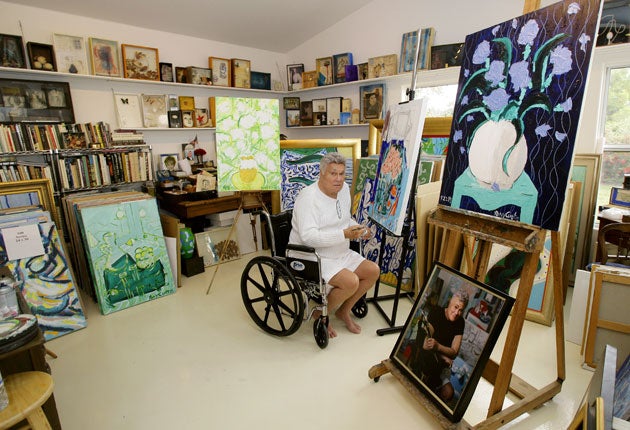Want to see my etchings, Sugar?
Actor, lover, bon viveur. But for the last 25 years of Tony Curtis's life, art was his passion – and the results are surprising

Little Bernie Schwartz from Brooklyn was a man who made a career out of reinventing himself, most notably as a Hollywood heart-throb called Tony Curtis. Then, there was his brief foray into womanhood as Josephine, the cross-dressing co-hero(ine) of Some Like It Hot. Both of these pale, though, beside Curtis's last great change of roles, from actor to artist – the role that was to consume him in the final decades of his life until his death this week at the age of 85.
After his film career hit the skids in the late 1970s (a slump helped along by addictions to alcohol and cocaine), Curtis took up painting. In part, this was by way of therapy – his first serious brush with the brush came during a long stint in the Betty Ford Clinic – but it was also driven by a genuine passion for making art.
Surprisingly for a man known as one of Hollywood's most infamous shaggers – Curtis was married six times, and quipped that the only leading lady he hadn't slept with was Jack Lemmon – his pictures showed a marked feminine sensibility. Where you might have imagined that the hero of Sex and the Single Girl would be drawn to the big-balled machismo of Picasso, his taste was actually for Matisse. More surprising still, he had a yen for painting cats, an animal to which he an unexpected devotion. Should you wish to, you can buy Curtis's giclée prints of Snowy, Sandy and Sprout off his website, www.tonycurtis.com, at $300 a mog.
These, like all his other works, show a real understanding of Matisse's method, flattening perspective into a surface pattern of vibrant blocks of colour. In a day when every celebrity seems to feel entitled to set up as an artist – Patti Smith and Bob Dylan spring unhappily to mind – Curtis's acrylics are genuinely accomplished: not great art, maybe, but not bad for all that.
No doubt fellow-stars who bought his paintings – Frank Sinatra, Burt Lancaster and Arnold Schwarzenegger were among the takers – did so primarily for the large "TONY CURTIS" scrawled in the bottom right-hand corner. But the Toronto Museum and National Museum of Hungary acquired his paintings because they thought they were good.
Nor did Curtis rest on his artistic laurels, but experimented with techniques such as photomontage. In the Noughties, when he was in his seventies, the retired heart-throb went through another reinvention, turning away from two dimensions to work in three.
In his house overlooking the Las Vegas Valley, he began to put together assemblages of found objects in boxes: old photographs and letters, golf balls, rosary beads and shot glasses housed in everything from packing crates to cigar cartons. As with Matisse and cats, this seemed a strangely feminine kind of art-making; Curtis's most obvious inspiration was probably the elderly Franco-American artist Louise Bourgeois. His stardom had been based on a beauty so extreme that it was almost feminine – yet he was a man comfortable enough in his masculinity to marry a woman like Janet Leigh.
Join our commenting forum
Join thought-provoking conversations, follow other Independent readers and see their replies
Comments